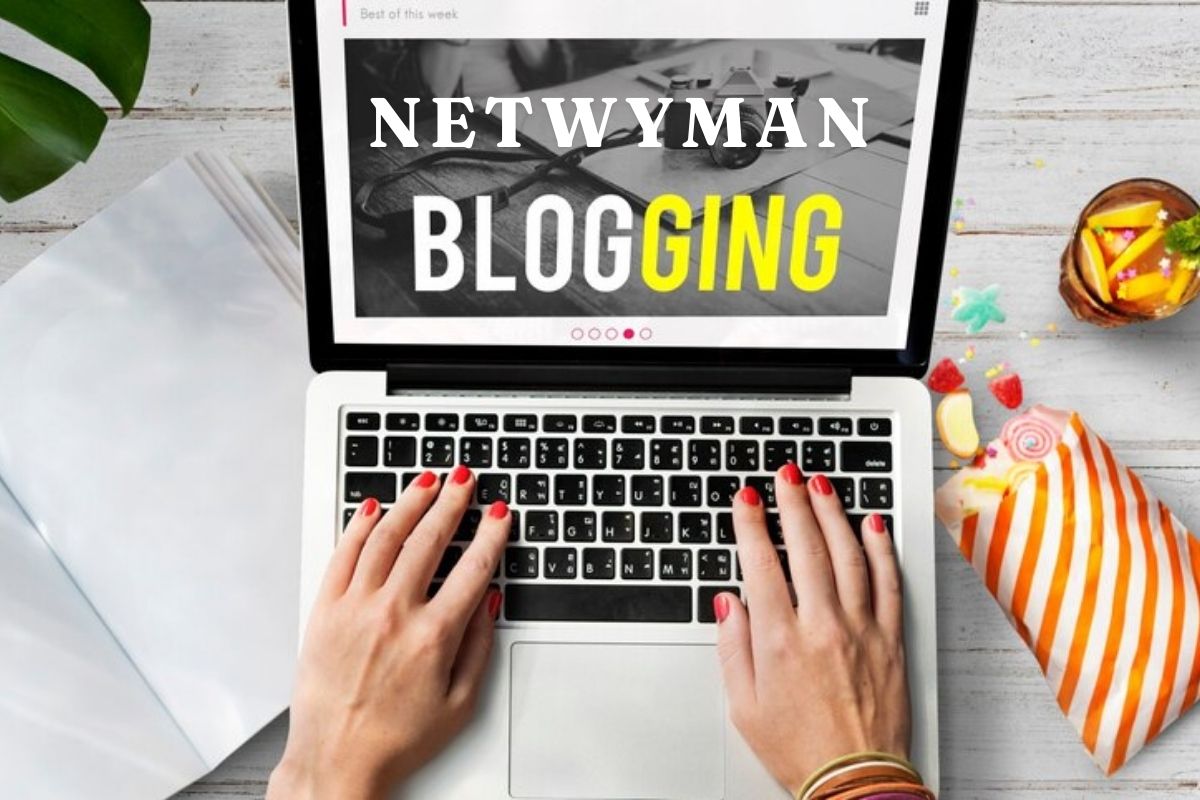Blogs
Netwyman Blogs: Ultimate Guide to Mastering Tech Blogging

Blogging is no longer just a hobby—it’s a powerful tool that drives 77% of internet users to consume content. And yet, not all blogs are created equal. That’s where Netwyman Blogs comes in. This platform isn’t your average one-size-fits-all blogging site. It’s built for those who want more—more control, more customization, and, let’s face it, more results.
Whether you’re a seasoned tech writer or just exploring how to create your first blog, you’re in the right place. Here, we’ll break down what makes Netwyman Blogs a game-changer. From superior SEO features to customizable designs, it’s the secret weapon for anyone serious about digital content. Ready to turn readers into loyal followers? Let’s get started!
What Is Netwyman Blogs?
At its core, Netwyman Blogs is a modern blogging platform tailored to meet the needs of tech enthusiasts, writers, and professionals who want to share detailed insights into their niche. Unlike conventional platforms like www.blogger.com login, which focuses on general users, Netwyman is built specifically for technical bloggers who need more advanced features, flexibility, and scalability.
Whether you are an experienced blogger or just stepping into the blogging world, Netwyman provides the tools and infrastructure necessary to create highly optimized and aesthetically pleasing blogs. Its primary focus is on providing writers with total control over their design, content, and distribution strategies, ensuring they can build a blog that truly reflects their brand.
Why Choose Netwyman Blogs Over Other Platforms?
When comparing Netwyman Blogs to other platforms like Blogger, WordPress, or Medium, a few distinct advantages stand out. For example, if you have ever used www.blogger.com login, you might have found it limiting in terms of customizability. Netwyman, on the other hand, allows for far more control over the blog’s layout, design, and even monetization strategies.
- Advanced Customization: One of the biggest advantages of Netwyman Blogs is its focus on giving the user full control over every aspect of their blog website. Unlike Blogger, which offers a simpler interface, Netwyman is designed for those who want to tailor their blog to a specific audience or niche.
- SEO Optimization: Built with SEO in mind, Netwyman helps you automatically optimize your content for search engines. This is crucial for driving organic traffic to your blog, especially in highly competitive niches. While platforms like WordPress also offer SEO plugins, Netwyman integrates these features right into the core of its system.
- Support for Niche Blogging: Whether you’re blogging about tech, programming, or what is blog in computer systems, Netwyman is built to accommodate deep dives into complex topics. Its structure encourages long-form content that is both informative and engaging—ideal for building authority in any niche.
How to Create a Blog on Netwyman
Creating a blog on Netwyman Blogs is both simple and effective, especially if you are familiar with other platforms like www.blogger.com login or WordPress. Below are the essential steps to get started:
- Sign Up and Set Up: The first step involves registering on the platform, much like any other blog platform. The registration process is straightforward, requiring just a few details about you and your intended blog focus.
- Select a Template: Netwyman offers a range of customizable templates designed specifically for technical content. Choose one that matches your style and start customizing it to make your blog stand out.
- Optimize SEO Settings: Before publishing your first post, take advantage of the built-in SEO tools that help you rank better on search engines. Ensure your titles, meta descriptions, and tags are all optimized for your target keywords.
- Start Writing: Once you’ve set up the structure of your blog, you’re ready to start posting. Netwyman encourages detailed and comprehensive content—ideal for bloggers asking, “what is blog writing?”
Blog Examples from Netwyman
If you’re wondering what makes Netwyman such an exceptional platform, just take a look at some blog examples hosted on the site. These blogs often delve into complex technical subjects like cloud computing, machine learning, and what is blog in computer networks, providing not only valuable insights but also demonstrating how to leverage Netwyman’s tools to create highly professional content.
These examples can serve as a guide if you’re still learning how to write a blog that resonates with your target audience. Whether you are explaining coding techniques, providing tutorials, or reviewing tech products, the platform’s extensive capabilities allow you to highlight your expertise in a compelling way.
What Is Blog Writing on Netwyman?
Blog writing involves crafting engaging, informative, and often educational content that resonates with a specific audience. When you choose to write on Netwyman Blogs, you are not just creating posts—you’re building a library of resources. Unlike simpler platforms, where blogging can be more of a hobby, Netwyman encourages its users to develop their blogs into full-fledged websites that offer detailed, authoritative content.
But what is blog writing exactly? In the digital age, blog writing has evolved into much more than just sharing personal thoughts. It involves researching, drafting, editing, and optimizing content to meet the needs of your readers while ensuring that it’s discoverable via search engines.
How to Write a Blog That Stands Out
Now that you know how to set up a blog on Netwyman, let’s explore some tips for creating standout content:
- Know Your Audience: Before writing your first post, take the time to understand who your readers are and what kind of content they are looking for. Netwyman Blogs offers insights into audience behavior, which can help you fine-tune your topics.
- Focus on Value: One reason why readers flock to blogs is the value they provide. Whether you’re writing about how to create a blog, offering a tutorial, or reviewing software, your content must solve a problem or answer a question that your audience has.
- Engage with Readers: Netwyman encourages interactive content, allowing you to build a community around your blog. Engage your readers with polls, comments, and questions. Encouraging discussion not only helps your blog grow but also keeps your audience coming back for more.
What Is Blog in Computer Terms?
In technical terms, a blog is a type of website or section of a website that is updated regularly with new content, typically in the form of articles or posts. The content is usually displayed in reverse chronological order, with the most recent post appearing at the top. While most blogs initially started as personal journals or diaries, they have evolved into essential tools for businesses, professionals, and individuals alike.
In the context of Netwyman Blogs, the platform takes the what is blog in computer definition to a whole new level by offering a specialized space for tech professionals to publish content that is both detailed and highly specific to their field.
Final Thoughts on Netwyman Blogs
For those serious about building a professional blog website, Netwyman Blogs is an excellent choice. It offers the flexibility, customization, and SEO tools needed to compete in today’s digital landscape. Whether you are an experienced blogger or just starting, the platform provides all the resources you need to create engaging, authoritative content that stands out in your niche.
By providing a wide array of features tailored to tech enthusiasts and professionals, Netwyman Blogs positions itself as more than just a blogging platform—it’s a tool for growth, community-building, and industry leadership.
Also Read: SpeedyShort.com: Streamlining Your Short-Term Rental Search
FAQs
What is Netwyman Blogs?
Netwyman Blogs is a specialized blogging platform designed for tech enthusiasts and professionals, offering advanced customization and SEO features for niche blogging.
How do I start a blog on Netwyman?
Sign up on the platform, select a template, and customize it according to your needs. Once set up, you can start posting content that is optimized for search engines.
How does Netwyman differ from Blogger?
Netwyman offers more advanced customization and SEO tools compared to www.blogger.com login, making it ideal for professional and niche blogging.
What is blog writing on Netwyman?
Blog writing on Netwyman involves creating detailed, niche-specific content that not only provides value to readers but is also optimized for SEO.
What are some blog examples on Netwyman?
Blogs on Netwyman often focus on technical topics like programming, computer networks, and software tutorials, providing deep insights and professional-level expertise.
What is blog in computer terms?
In computer terms, a blog is a website or part of a website that is updated with new content regularly, typically displayed in reverse chronological order.
Blogs
поррозаб: The Ultimate Guide to Origins, Uses, and Benefits

Introduction To поррозаб
поррозаб is a fascinating term whose meaning and application have piqued the curiosity of many. Whether it relates to a specific cultural tradition, a concept, or a practical product, porrozab offers layers of complexity. In this article, we will dive deep into its origins, potential meanings, and explore how it is applied in various fields. If you’re eager to understand the background, uses, and possible benefits of porrozab, you’re in the right place.
What is Porrozab?
поррозаб might not be a widely known word across the globe, but it carries substantial meaning in specific contexts. Depending on the regional or cultural background, the word may refer to a concept, practice, product, or even a philosophy.
Some hypotheses suggest that porrozab is rooted in ancient practices or local terminology tied to craftsmanship or everyday life. Others believe it could involve modern innovations, blending tradition with technology. Its versatility makes it worth exploring, especially if you seek applications across industries like health, art, or lifestyle.
The Origins and Meaning of Porrozab
Where does the word поррозаб come from? While there isn’t extensive documentation about the origins, linguistic evidence hints that it may derive from Slavic, Turkic, or Central Asian languages. Its structure suggests a blend of tradition and modern adaptation, indicating that the term has evolved over centuries.
Porrozab could also have deep cultural relevance, being passed down through generations and continuing to shape various aspects of daily living or craft. Much like folk concepts that remain relevant, porrozab seems to bridge the past and present in meaningful ways.
Porrozab in Everyday Life
поррозаб seems applicable across multiple sectors, whether in daily routines, professional practices, or creative industries. Let’s explore a few areas where porrozab could add value:
- Health and Wellness: Perhaps porrozab refers to a method or technique in relaxation, mental well-being, or even alternative medicine. Traditional practices such as herbal remedies or breathing exercises could align with this concept.
- Craft and Design: If porrozab originates from craftsmanship, it could be linked to handicrafts, artisanal products, or a philosophy of mindful creation.
- Technology and Modern Solutions: It’s also possible that porrozab is associated with innovations or techniques in product design or problem-solving strategies.
In these diverse domains, поррозаб symbolizes practical utility and creative inspiration, suggesting that it could apply broadly across many disciplines.
Benefits of Porrozab
The value of поррозаб lies in its potential to inspire creativity, boost well-being, or encourage efficiency. Below are some hypothetical benefits that porrozab could provide:
- Promotes Creativity: If porrozab connects with artistic or design elements, practicing it could encourage unique solutions or creative breakthroughs.
- Enhances Mental Well-being: As a philosophy, porrozab could focus on relaxation or mindfulness, offering an effective way to handle stress.
- Encourages Sustainability: If tied to craftsmanship, porrozab might emphasize eco-friendly practices, ensuring long-term environmental benefits.
- Increases Productivity: In professional settings, porrozab may provide tools or techniques to enhance work efficiency.
Whether it’s through mental clarity, creative insights, or sustainable practices, поррозаб offers a framework for holistic living and innovation.
Porrozab in Modern Contexts
As times evolve, many ancient practices find new relevance. Porrozab could align with contemporary trends in mental health, slow living, or even technology.
Imagine using the principles of porrozab to design eco-friendly products or cultivate a healthier work environment. It could also play a role in minimalism and sustainable lifestyles, reminding us to value simplicity and mindfulness.
How to Incorporate Porrozab into Your Life
If you wish to integrate the concept of porrozab, here are some ideas:
- Practice Mindful Craftsmanship: Dedicate time to creating something by hand, focusing on the joy of the process rather than the end product.
- Embrace Slow Living: Reduce unnecessary tasks and engage with life in a more thoughtful, relaxed way.
- Use Technology Wisely: Incorporate digital solutions only where they enhance your quality of life without overwhelming you.
- Stay Curious and Open-minded: Porrozab could be a concept that grows with you, expanding its meaning as you learn and explore new perspectives.
Conclusion
Porrozab stands as a versatile and meaningful concept, hinting at practical and philosophical significance. Though its origins may be mysterious, its potential applications span multiple areas, including mental wellness, sustainable living, and creative industries. If you’re intrigued by the blend of tradition and modernity, porrozab might be the ideal philosophy to explore.
In a fast-paced world, porrozab reminds us to pause, reflect, and engage meaningfully with life and work. Whether you wish to integrate it into your personal routine or professional space, the opportunities are endless. Embrace porrozab to cultivate mindfulness, creativity, and sustainability in everything you do.
Also Read: Mastering the NYT Connections Game: Essential Hints and Strategies
FAQs
What is porrozab?
Porrozab is a concept that may refer to a practice, philosophy, product, or idea, potentially linked to traditional and modern applications.
Where does the word porrozab come from?
It is likely rooted in Slavic, Turkic, or Central Asian traditions, though its exact origins remain unclear.
How can porrozab be applied today?
Porrozab can be incorporated into creative work, mental wellness routines, and sustainable practices.
Does porrozab have health benefits?
If porrozab involves relaxation techniques or mindfulness, it may promote mental well-being and reduce stress.
Is porrozab related to any specific industry?
Porrozab seems versatile, finding potential use in art, design, technology, and health sectors.
How can I begin practicing porrozab?
Start by focusing on mindful activities—whether through crafting, slowing down your routine, or embracing sustainable habits.
Blogs
10 Expert Connections hint That Will Transform Your Relationships
Blogs
Mastering the NYT Connections Game: Essential Hints and Strategies

Nyt Connections hint game has become a popular puzzle challenge that invites players to think critically and make meaningful connections between words, objects, or concepts. Like many other games from the New York Times, it draws players in with its seemingly simple design but quickly proves to be far more complex. If you’ve found yourself stuck or scratching your head, you’ve come to the right place. Let’s dive into the best tips and hints for conquering this addictive word puzzle.
What is NYT Connections?
The NYT Connections game is a brain-teasing puzzle that challenges you to group items based on shared connections. These connections could be related to meanings, themes, categories, or even word structures. The goal is to identify these relationships and group the items correctly, making it both a test of vocabulary and logic.
At first glance, it might seem like a breeze, but as the puzzles grow more intricate, so do the connections. It’s essential to approach each puzzle strategically to avoid getting stuck or overwhelmed.
How NYT Connections Works
In every NYT Connections puzzle, players are presented with a grid of words. Your task is to sort the words into categories by finding four distinct groups of four related items. The trick lies in identifying the common thread linking the items within each group. Some connections might be obvious, but others are designed to throw you off track.
For example, if the words are related to animals, colors, or even abstract ideas like emotions or actions, you need to think beyond the literal meaning of each word. You must figure out the subtle ways they could be connected.
NYT Connections Hint: Start with the Obvious
One of the best approaches to solving NYT Connections puzzles is to start with the most obvious words or groupings. When you first see the list, some words will naturally stick out as being part of a particular theme. Start there. For instance, if you see words like “cat,” “dog,” “parrot,” and “goldfish,” it’s safe to assume they all belong to the “Pets” category.
Starting with easy connections helps build momentum, and once you’ve grouped the straightforward items, it becomes easier to decipher the trickier ones.
Pay Attention to Word Ambiguity
NYT Connections loves to challenge players by including words that have multiple meanings or could fit into more than one category. For example, a word like “spring” could refer to a season, a mechanical device, or even a body of water. Always keep in mind the possibility that a word might not mean what you first assume.
By remaining open to different interpretations of a word, you’ll increase your chances of identifying the correct grouping. Also, beware of false connections! Some words might seem to go together at first glance, but after careful thought, you’ll realize they belong in entirely different groups.
Hints for Solving Difficult Puzzles
Once you’ve grouped the most apparent items, you might hit a wall. This is where the following hints come in handy for those more difficult puzzles:
- Cross-referencing categories: Try to think about how categories interact. If you’re stuck, mentally eliminate words from categories you’ve already identified. This way, you narrow down your options and can focus more clearly on what’s left.
- Look for thematic overlap: Sometimes words might seem unrelated until you spot an overarching theme. For example, “wheel,” “rudder,” “pedal,” and “engine” all might appear in different contexts, but they’re all parts of vehicles.
- Think outside the box: Some connections are more abstract than others. Don’t limit your thinking to traditional categories. For instance, if words seem random, try to identify if they’re linked by a specific industry, event, or cultural reference.
Why You Should Take Your Time
Solving the NYT Connections puzzles isn’t about rushing to the finish line; it’s about taking your time to explore potential groupings. If you’re feeling stuck, it can often help to walk away and return with a fresh perspective. The game encourages patience and persistence, and sometimes a quick break is all it takes to see the puzzle in a new light.
Unlike other puzzles, where speed is key, here it’s more important to think critically and creatively. Many of the most satisfying moments come from making an unexpected connection that ties the entire puzzle together.
Common Mistakes and How to Avoid Them
As you play the NYT Connections game, you might encounter some common pitfalls that can slow you down. Here’s how to avoid them:
- Overthinking connections: One of the most common mistakes is over-complicating the relationships between words. Sometimes the connection is much simpler than you think. If you’re spinning your wheels on a potential solution, step back and reassess.
- Ignoring synonyms or related terms: Don’t forget that some connections might not be direct but rather conceptual. Words like “fast” and “quick” might not be obvious at first, but they share a similar meaning. Always consider synonyms or related ideas.
- Forgetting to double-check previous groupings: Sometimes, you may rush to group words together, but in doing so, miss out on a better fit elsewhere. It’s always a good idea to revisit previous groupings to make sure they still hold up as more words are grouped.
NYT Connections Hint: Use a Process of Elimination
One effective strategy for tough puzzles is to use the process of elimination. By removing the words that you’ve already grouped, you shrink the pool of potential answers, making it easier to focus on what’s left. This helps when you’re dealing with those last tricky connections that seem to defy categorization.
After forming a few groups, you can go back to review which words remain. Often, you’ll spot connections that weren’t initially apparent.
Practice Makes Perfect
As with any puzzle game, the more you practice, the better you’ll become at solving NYT Connections. Over time, you’ll start recognizing patterns, common themes, and word groupings more quickly. You may even begin to anticipate the kinds of tricky connections the game throws your way.
A regular routine of playing can sharpen your cognitive abilities, improve your vocabulary, and strengthen your problem-solving skills.
Where to Find Additional Help
If you’re still finding it difficult to crack the NYT Connections puzzles, don’t worry. The New York Times puzzle community is vast and enthusiastic, offering forums, blogs, and discussion threads where you can find insights or hints from fellow players. Just make sure to avoid spoilers if you’re determined to solve the puzzles on your own.
Additionally, many websites and puzzle-solving communities provide gentle hints, giving you just enough direction without outright revealing the answers. This can be an excellent resource when you need a little nudge in the right direction.
Final Thoughts
The NYT Connections puzzle is a delightful mix of wit, strategy, and linguistic knowledge. It tests your ability to think critically, identify subtle relationships, and look at words from different perspectives. By starting with the obvious, remaining patient, and applying strategic techniques like the process of elimination, you can master even the toughest puzzles. While it might be challenging at first, don’t get discouraged. Every puzzle solved is a testament to your growing skills and persistence.
Also Read: Paul Inouye Wife: Everything You Need to Know About His Marriage and Personal Life
FAQs
How do you solve NYT Connections puzzles efficiently?
Focus on grouping the most obvious connections first, and then use a process of elimination to narrow down your options. Look for both literal and abstract relationships between words.
What is the key to mastering NYT Connections?
Patience and practice are key. Start with obvious groupings, be open to multiple interpretations of words, and don’t hesitate to double-check your earlier assumptions.
Can I find hints for NYT Connections online?
Yes, several forums and blogs provide hints without giving away the answers. These resources can be helpful when you’re stuck and need a little guidance.
Why are some NYT Connections puzzles so difficult?
The puzzles increase in difficulty by incorporating more abstract or less obvious connections, requiring players to think creatively and critically about the relationships between words.
What should I do if I can’t solve a puzzle?
If you’re stuck, take a break and return with fresh eyes. Sometimes stepping away can help you see the connections more clearly. You can also seek hints online for additional help.
How often are new NYT Connections puzzles released?
NYT Connections is updated regularly with new puzzles, ensuring that players always have a fresh challenge to tackle.
-

 Blogs9 months ago
Blogs9 months agoпоррозаб: The Ultimate Guide to Origins, Uses, and Benefits
-

 Technology10 months ago
Technology10 months agoHonor Magic 5 Pro: A Comprehensive Review
-

 Blogs10 months ago
Blogs10 months agoMobileHomeExteriors.com: Elevating Your Mobile Home’s Curb Appeal
-

 News10 months ago
News10 months agoShari Ann Chinnis: A Pillar of Leadership and Service in Indianapolis
-

 Entertainment10 months ago
Entertainment10 months agoFrench Stream.moe : Ultimate Guide to Watch Free Now
-

 Law10 months ago
Law10 months agoPaul Mackoul, MD: A Closer Look at the Recent Lawsuit and Its Implications
-

 Technology10 months ago
Technology10 months agoMaximizing Efficiency with Identifier b88221141 System
-

 Health10 months ago
Health10 months agoUnlocking the Secrets to Health and Wellness: Insights from The //Vital-Mag.net

